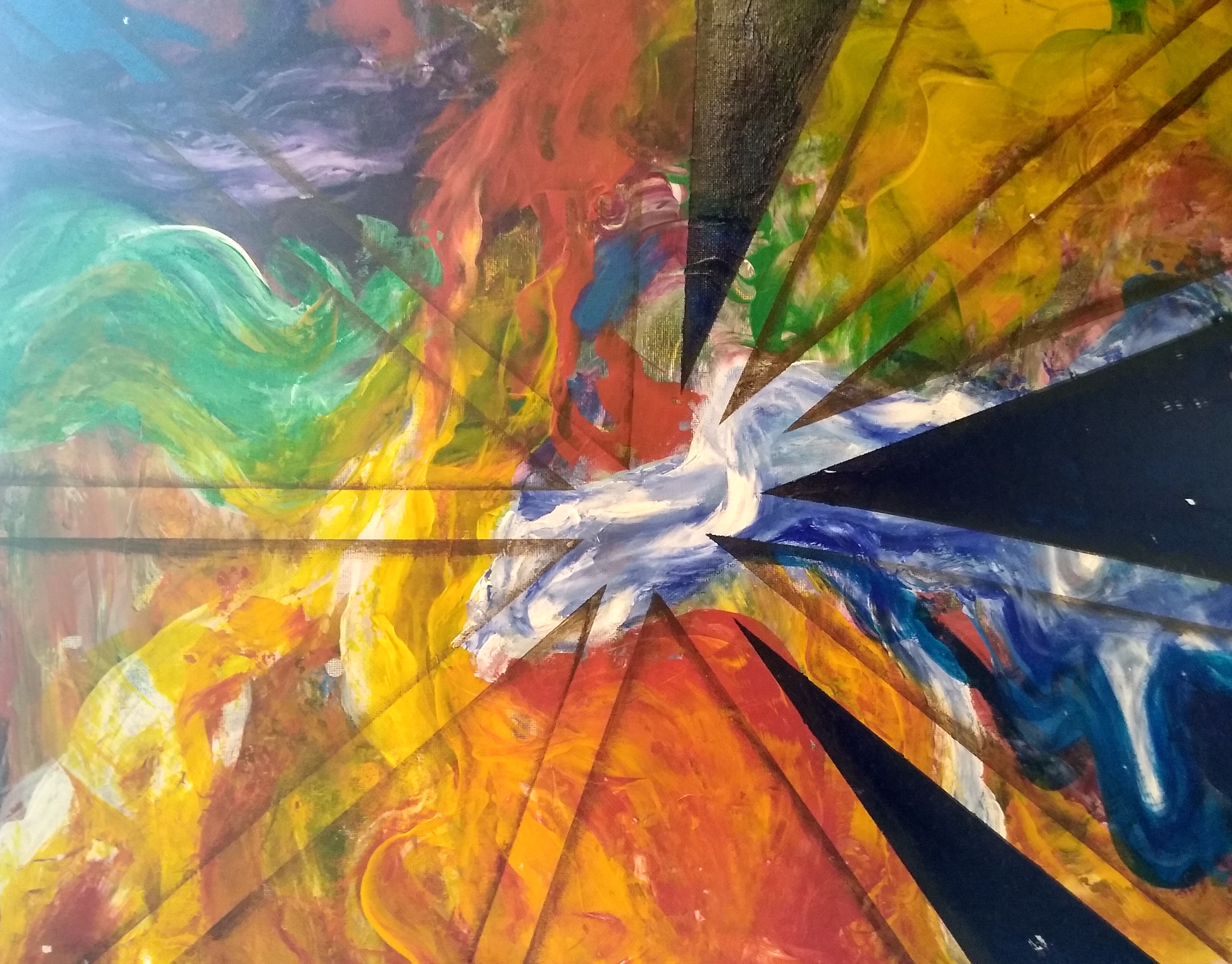About this Product
Color Palette:
Warm Colors: Reds, yellows, and oranges dominate one side of the painting, giving it an intense, fiery energy.
Cool Colors: Greens, blues, and purples balance the composition on the other side, evoking a sense of calm and fluidity.
Neutral Tones: White and black are contrasting elements, with white emphasizing the central vortex and black adding depth and division.
Center Focal Point:
The center of the painting features a swirling mix of white and blue tones, resembling a vortex or an explosion of energy. This creates a strong visual pull, guiding the viewer's eye to the heart of the composition. The blending in this area is smooth, suggesting motion and intensity.
Lines and Structure:
Sharp black triangular sections radiate outward from the center, creating a fragmented, geometric effect. These lines divide the canvas into distinct sections while maintaining the focus on the central energy.
The contrast between the fluid, colorful background and the rigid black lines adds tension and balance to the work.
Textures and Brushwork:
The brushstrokes are bold and expressive, especially in the colorful areas, which display a mix of thick and blended textures.
There may also be palette knife work or layering techniques to create variation in texture, particularly in the swirling sections.
Mood and Interpretation:
The painting feels vibrant, energetic, and full of movement, evoking themes of creation, chaos, or transformation. The balance between warm and cool colors, as well as the contrast between the fluid and structured elements, suggests a harmony between opposing forces.
Visual Impact:
This artwork draws the viewer in with its bold contrasts and dynamic layout. The radiating design creates a sense of infinite motion, while the interplay of vibrant colors invites deeper exploration.
Baribault studios
Meet the Maker
Jill Baribault is a celebrated artist and designer whose work transcends conventional boundaries, blending imagination with craftsmanship. As the creative force behind Baribault Studios, Jill has become known for her ability to transform ideas into stunning visual narratives. Her passion for art was ignited at an early age, drawing inspiration from the natural world, vibrant cultural motifs, and the timeless elegance of human emotion.
With a background in [insert relevant artistic or educational background, if known], Jill honed her skills across a variety of media, including [list key specialties, e.g., painting, sculpture, interior design, digital art, etc.]. Her works are marked by their meticulous attention to detail, innovative techniques, and an unerring commitment to storytelling through design.
Jill’s artistry has been showcased in [insert exhibitions, notable projects, collaborations, or features], earning her acclaim for her unique perspective and masterful execution. Beyond her studio, she is a passionate advocate for [mention philanthropic work, mentoring, or community involvement, if applicable], believing that art has the power to inspire, connect, and transform lives.
Today, Jill continues to push the boundaries of creativity, crafting pieces that resonate with depth, beauty, and originality, leaving a lasting imprint on the art and design landscape.
_jpg_363552128372_1732372938.jpeg?t=1732372938)
How it’s Made
1. Preparing the Canvas
The artist likely used a primed canvas or canvas board as the foundation, ensuring it was smooth and ready to hold layers of acrylic paint.
A light base coat of neutral or white paint might have been applied to create an even surface on which the vibrant colors could pop.
2. Planning the Composition
The design includes radiating triangular segments that converge toward a central focal point. This layout may have been pre-sketched with pencil, chalk, or masking tape to create the sharp, defined edges.
3. Applying Base Colors
Background Layers:
Broad, swirling brushstrokes of primary and secondary colors—reds, yellows, greens, blues, and purples—were applied. This was likely done with a mix of brushes, palette knives, and possibly even sponges to create textured, blended areas of color.
The colors seem to have been layered to create depth, with some areas of translucency suggesting glazes or diluted acrylic paints.
4. Creating the Radiating Lines
The sharp black triangular lines radiating from the center were either masked off using painter’s tape or painted freehand with a steady brush. The black areas create contrast and direct the viewer’s eye toward the center.
These lines may have been added after the background colors were dry to ensure clean edges.
5. Enhancing the Center Focal Point
The center of the painting features a swirling mix of white and blue tones, creating a sense of energy and movement, almost like an explosion or vortex.
This effect could have been achieved using quick, dynamic strokes with a brush or palette knife while blending wet paints directly on the canvas.
6. Layering and Blending
The transitions between colors are smooth in some areas and sharp in others, suggesting the use of both wet-on-wet techniques (for blending) and layering (for defined edges).
Palette knives or brushes with varied stiffness may have been used to manipulate paint thickness and texture.
7. Final Details
The artist added small touches, such as subtle textures in the colored areas or highlights in the center, to give the piece more depth and visual interest.
Black paint was used to enhance the triangular sections, ensuring they stand out against the vibrant background.
8. Varnishing
A protective layer of acrylic varnish may have been applied to seal the painting and enhance the vibrancy of the colors.
Interpretation of the Process
This painting seems to reflect a balance between control (evident in the sharp black sections) and freedom (evident in the swirling, vibrant background). It combines abstraction with a strong compositional structure, showcasing the artist's ability to harmonize chaos and order.




_jpg_655612301460_1733017129.jpeg?t=1733910316)

